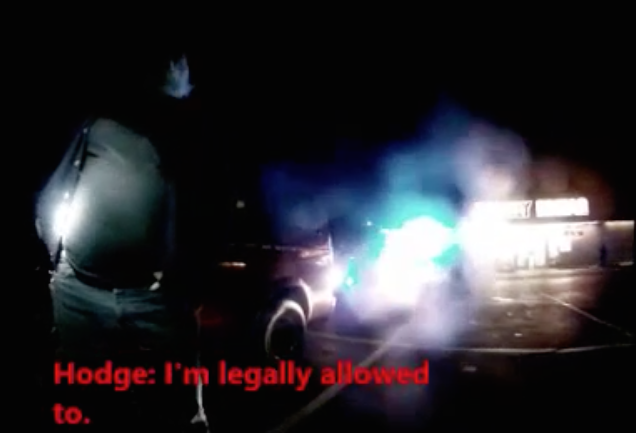On December 22, 2015, Ludlow, Ky., Police Officer Sam Hodge made a traffic stop on Charles Reynolds, 61. When Hodge activated his lights to make the initial stop Reynolds refused to pull over. Minutes later he did pull into the lot of a local grocery store.
Officer Hodge approached the vehicle and Reynolds made known that he was carrying a gun. Hodge had Reynolds exit his vehicle. It was when the officer asked Reynolds to turn around that the situation quickly intensified ultimately resulting in a deadly force event where both men were shot, Reynolds fatally.
The attached video was produced and edited by the River City News of Covington, K.Y. They did an exceptional job of highlighting the many variables that confront officers on a daily basis. From the limitations of body cameras and lighting issues for officers working after sundown to the speed of an attack and the terrifying aftermath this attached video demonstrates the dangers of dealing with those who wish to harm police officers.
The video shows, albeit in a limited capacity due to lighting conditions, Reynolds putting his hands behind his back and at waist level as he stands outside his truck. This behavior is a distinct danger cue. When the officer tells the motorist to reveal his hands, Reynolds refuses and begins to argue.
“Calming Tones”
Many in the mainstream media—and now also in the ranks of upper management in law enforcement— advocate using a kinder and gentler approach when dealing with confrontational subjects. The argument is that calming voices will calm and then rationalize the irrational. Harsh and officious behavior, on the other hand, will only serve to further agitate.
Listen: I lack any true talent. I can’t hammer two sticks together, know nothing about car engines, and even less about plumbing and electricity. What I do know is communication.
I was very good at calming the irrational as well as selling prison to those who had no interest in buying. Getting confessions was my forte. A tenet of good interviewing and interrogating is to let the other person know that you recognize their value and worth. Treating them with dignity and respect definitely works.
But not all the time.
The incessant mantra of late that guarantees that “calming tones” will almost always work is, frankly, nonsense. The problem is that the elites and intellectuals lack any real-life experience when it comes to dealing with the people who are extremely agitated, mentally unstable and/or have true evil in their hearts.
Something that was always funny to me was how often the mental health professionals would call 9-1-1 when they couldn’t calm the irrational in their own clinics. I remember showing up as a lieutenant one time and watching my cops trying to deal with a highly agitated person who was dropped off by a family who couldn’t control him. Both officers, neither of whom I believe went to college, did a remarkable job in calming the person. Meanwhile the Ph.Ds were hiding behind the counter.
Another time we were there one of the officers used a Taser to help control the subject and get him on the stretcher that was waiting to take the man to the hospital. One of the staff psychologists complained to me that the Taser was used. He said something like, “You guys should have tried talking to him more.”
“It didn’t work for you and you’re the professionals,” I said. “Sometimes you just have to make them.”
Bottom line: There is absolutely no ‘cookie-cutter’ approach to dealing with people who are highly charged, emotionally stressed and/or intent on violence.
Command Presence
Clearly throughout this encounter and captured on the video edit, the driver was argumentative and agitated. I believe that in this particular case, Officer Hodge did a great job on every front. He was looking into the face of someone who had no intention of cooperating and who appeared to be looking for a fight: a fight that he eventually found. Unfortunately for him it was against a true Guardian-Warrior. Officer Hodge was prepared to act, did act, and went home to his loved ones.
From the beginning of the encounter Officer Hodge exhibited a command presence. Some, I’m sure, will find problems with most everything he did. Some will say that he had no right making the stop, was too overbearing in his tone of voice, or maybe even beyond the scope of the law. None of which is true.
When Officer Hodge told Reynolds to show his hands Reynolds instead demanded that Hodge remove his hands from the area of his duty sidearm.
Hodge responded by saying, “I am legally allowed to do so.”
“So am I,” Reynolds replied.
Within seconds shots are heard and the camera goes black.
When the viewing field returns Hodge is on the ground, there is blood on the camera lens and he is shot in the arm/shoulder area. A citizen, later identified as a James Megerle, runs in to assist the officer by telling him to stay on the ground, treating his wound and even kicking the gun away from the fallen Reynolds.
Megerle was recently awarded a plaque for his heroism.
Conclusion
Watch the video and as you do, consider this: There is no one way to do this job as there are about 320 million different personalities and moods in this country at any given second. This video illustrates the dangers, speed and determination of someone who just hates.
In this case the hater ran across the wrong cop.











0 Comments